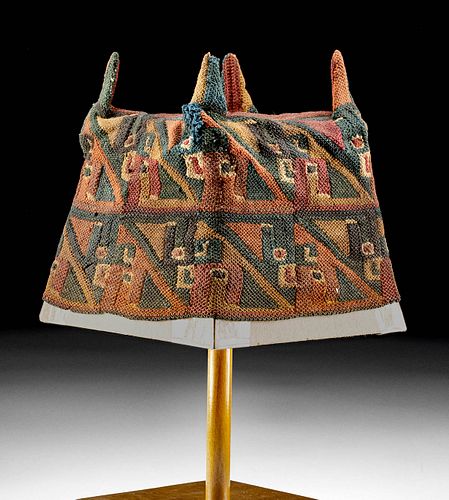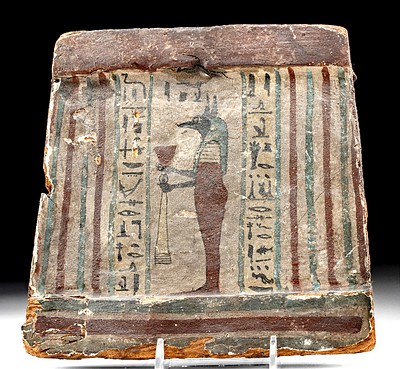Tiahuanaco / Huari Polychrome Textile Four Corner Hat
Lot 111
About Seller
Artemis Gallery
686 S Taylor Ave, Ste 106
Louisville, CO 80027
United States
Selling antiquities, ancient and ethnographic art online since 1993, Artemis Gallery specializes in Classical Antiquities (Egyptian, Greek, Roman, Near Eastern), Asian, Pre-Columbian, African / Tribal / Oceanographic art. Our extensive inventory includes pottery, stone, metal, wood, glass and textil...Read more
Estimate:
$7,000 - $10,500
Absentee vs Live bid
Two ways to bid:
- Leave a max absentee bid and the platform will bid on your behalf up to your maximum bid during the live auction.
- Bid live during the auction and your bids will be submitted real-time to the auctioneer.
Bid Increments
| Price | Bid Increment |
|---|---|
| $0 | $25 |
| $300 | $50 |
| $1,000 | $100 |
| $2,000 | $250 |
| $5,000 | $500 |
| $10,000 | $1,000 |
| $20,000 | $2,500 |
| $50,000 | $5,000 |
| $100,000 | $10,000 |
| $200,000 | $20,000 |
About Auction
By Artemis Gallery
Aug 26, 2021
Set Reminder
2021-08-26 10:00:00
2021-08-26 10:00:00
America/New_York
Bidsquare
Bidsquare : Fine Antiquities | Asian | Ethnographic Art
https://www.bidsquare.com/auctions/artemis-gallery/fine-antiquities-asian-ethnographic-art-7366
Features classical antiquities, ancient and ethnographic art from cultures encompassing the globe. Egyptian, Greek, Roman, Etruscan, Near Eastern, Asian, Pre-Columbian, Native American, African / Tribal, Oceanic, Spanish Colonial, Russian, Fine / Visual Arts, so much more! Artemis Gallery info@artemisgallery.com
Features classical antiquities, ancient and ethnographic art from cultures encompassing the globe. Egyptian, Greek, Roman, Etruscan, Near Eastern, Asian, Pre-Columbian, Native American, African / Tribal, Oceanic, Spanish Colonial, Russian, Fine / Visual Arts, so much more! Artemis Gallery info@artemisgallery.com
- Lot Description
Pre-Columbian, Bolivia, Tiahuanaco (Tiwanaku) or Huari (Wari) culture, ca. 600 to 900 CE. A lovely four cornered hat woven from a camelid (alpaca or llama) fiber that is dyed in hues of red, yellow, dark blue, and blue-green. Each side of this hat is divided into sections featuring a repeating geometric pattern of interlocking triangular and rectangular shapes. Four cornered hats are associated with two ancient cultures of the Andes: the Huari and the Tiahuanaco. These two cultures developed alongside each other, occupying neighboring lands, and shared similar weaving techniques and programs that reflected their related religious beliefs. Huari ceramics containing figures are often depicted wearing these square hats, perhaps as indicators of rank. The natural dyes and motifs are beautifully preserved in this hat and demonstrate the remarkable skill of these Pre-Columbian weavers. Size: 5" W x 4.25" H (12.7 cm x 10.8 cm); 10" H (25.4 cm) on included custom stand.
Textiles and items containing woven textile materials were some of the most valuable items in Huari culture as they probably exacted them as tribute from the peoples they conquered. This makes it difficult for archaeologists to identify where these beautiful objects were originally woven, because they travelled so much around the Huari Empire. An informative essay on the Metropolitan Museum of Art website presents a nice discussion about techniques that are specific to the Huari and Tiahuanaco four-cornered hats: "Although they shared certain technological traditions, such as complex tapestry weaving and knotting techniques, the Wari and the Tiwanaku utilized significantly different construction methods to create four-cornered hats. Wari artists typically fashioned the top and corner peaks as separate parts and later assembled them together. Tiwanaku artists generally knotted from the top down, starting with the top and four peaks, to create a single piece. In addition, four-cornered hats knotted with pile have largely been discovered at Wari sites, while those knotted without pile have been found in Tiwanaku burials. Through these variances, scholars have been able to attribute individual works to one group or the other."
Provenance: ex-Steve Berger collection, San Francisco Bay area, California, USA
All items legal to buy/sell under U.S. Statute covering cultural patrimony Code 2600, CHAPTER 14, and are guaranteed to be as described or your money back.
A Certificate of Authenticity will accompany all winning bids.
PLEASE NOTE: Due to recent increases of shipments being seized by Australian & German customs (even for items with pre-UNESCO provenance), we will no longer ship most antiquities and ancient Chinese art to Australia & Germany. For categories of items that are acceptable to ship to Australia or Germany, please contact us directly or work with your local customs brokerage firm.
Display stands not described as included/custom in the item description are for photography purposes only and will not be included with the item upon shipping.
#164360Modern cloth sewn to three areas on interior to stabilize areas of tearing and fraying. Perforations and fraying to textile as shown. Losses to hem. Nice preservation of motifs and colors.Condition
- Shipping Info
-
All shipping is handled in-house for your convenience. Your invoice from Artemis Gallery will include shipping calculation instructions. If in doubt, please inquire BEFORE bidding for estimated shipping costs for individual items.
-
- Buyer's Premium



 EUR
EUR CAD
CAD AUD
AUD GBP
GBP MXN
MXN HKD
HKD CNY
CNY MYR
MYR SEK
SEK SGD
SGD CHF
CHF THB
THB













